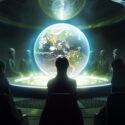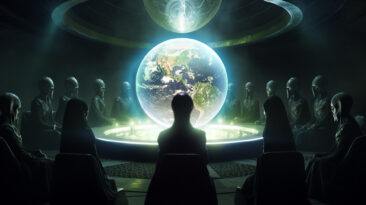The Universe is a mind-boggling place. Actually, I’m not even sure I can call it a place. NASA says the Universe is everything, but what they really mean is that it contains everything. All of space, energy, time, and matter like you and me. But there’s more to it than meets the eye… literally. All ordinary matter, like the particles that form us and everything else we can see, only comprise about 5% of the Universe. So that’s all the stuff that makes up our stars, planets, and galaxies. And we’ve only been able to see about half of all that with our telescopes. The rest is entirely invisible. It’s as if the Universe doesn’t like being put under our microscope, or telescope, to be more precise.
Around 27% of our Universe is dark matter, which emits no light or energy and can’t be detected by conventional sensors and detectors. We don’t even know what it’s really made of, and to be completely honest, we’re not even sure it exists… we can only assume. To be fair, we have strong reason to believe dark matter exists. As early as the 1920s, astronomers hypothesized that the Universe must contain more matter than we can see because the Universe’s gravitational forces appear stronger than visible matter can account for. It’s a matter of simple math. Ok, probably not simple math, but you get the idea.
As if this wasn’t confusing enough, the remaining 68% of the Universe is made up of dark energy. Just like dark matter, dark energy is purely theoretical. It popped on our radars in 1998 when the Hubble telescope discovered that, in the past, the Universe expanded at a slower rate than it does today. And if the Universe is now growing at an increasing rate, then there must be a force countering gravity and causing this acceleration. Wait, did I just describe repulsive gravity? As you can see, or can’t actually, there’s a lot of speculation when it comes to developing a blueprint for understanding the Universe and everything in it. Even if we focused solely on the visible 5%, there’s still a lot to unpack. Next time you find yourself gazing at a sky full of stars, take a moment and try to count how many you can see. Let me help you. On a clear night, there are about 6,000. But if we wanted to calculate the number of stars in the entire Universe, first, we’d have to count the galaxies. To do that, astronomers take very detailed pictures of small parts of the sky and count the galaxies in those pictures. Then they multiply that number by the images needed to photograph the entire sky.
Are you ready for the answer? There are approximately 2 trillion galaxies in the Universe. 2 trillion clusters of dust swirling in a mostly invisible Universe harboring countless stars, planets, and even civilizations. Our Milky Way Galaxy alone is home to 100 billion stars. Using this number as a standard, we can predict that there are roughly 200 billion trillion stars in the Universe. A staggering number, I know. It’s about ten times the number of cups of water in Earth’s oceans. In our galaxy, the Milky Way, every star has at least one planet orbiting it, meaning there are at least 100 billion exoplanets in our galaxy alone.
To date, NASA has discovered more than 5,000 of them. The big question that has been haunting us ever since we developed the mental capacity to ponder our existence in this vast Universe is still unanswered: Are we alone in the Universe? Well, according to Enrico Fermi, a Nobel-Prize-winning Physicist, considering the young age of our Solar System compared to the much older age of the Universe and that interstellar travel should be easy to achieve given enough time, Earth should have been visited by intelligent aliens by now, if they did exist.
This interpretation became known as the Fermi Paradox, and it provides no consolation to our lonely existence. But what if life isn’t as unique as we think it is? What if the Universe is teeming with countless species far more intelligent than we are? Species that know of our existence and even visit us, only to deem us unfit or too primitive for interaction? Think about an ant colony that you happen to come across through your walk in the park. Would you try to communicate with them? It would be pointless, wouldn’t it? If you’re having a bad day, you might even go out of your way to step on them. Maybe our entire existence is equivalent to an ant colony placed in this region of the Universe by some sort of higher intelligence. An isolated experiment with no particular purpose.
Ok, I’ll admit, that was a bit dark. Let’s bring some light back into the equation.
Light is the fastest thing in the Universe. In a vacuum, it can travel at speeds close to 300,000 km/s (186,000 m/s). To put that in perspective, light can circulate the Earth 7.5 times in just one second. Even at these insane speeds, it would take light 92 billion years to travel across the observable Universe. Yes, that’s where the measurement light year comes from. Light is strange. It’s an electromagnetic wave of massless particles called photons that travel outwards in straight lines. But how can it travel around the Earth if it moves in straight lines? Maybe Earth is flat, after all? I won’t get into that right now, but I made an entire video about it; you should check it out. Spoiler, though, it isn’t. While light does travel in straight lines, it can also be bent by gravity. Contrary to what we were taught in school, gravity is not a force. It doesn’t pull anything downward. Instead, it just curves the fabric of the Universe.
If you’re confused, don’t feel bad, gravity has confounded the best of us. Winston Churchill famously said that gravity is “a riddle, wrapped in a mystery, inside an enigma.” But we’ve put our best scientists on it, and while Newton gave us a good understanding of gravity, it was Einstein who cracked its code. To do so, Einstein first had to reimagine three-dimensional space by adding time to the equation. The outcome is a four-dimensional construct called space-time. A mass like the Sun warps this fabric by creating a valley, and then planets like Earth circle around the valley like a ball around a roulette wheel. This is what we call the force of gravity.
Einstein had quite the imagination. Before he was recognized as a genius, he worked as a patent clerk and had a lot of time to think about well… time. In his special relativity theory, Einstein proved that time is relative to the observer, meaning that when an object is moving really fast, it experiences time more slowly. For example, in 2015, astronaut Scott Kelly spent nearly a year onboard the International Space Station, which meant he was moving much faster than his twin brother Mark, who was on the Earth’s surface. Based on Einstein’s special relativity theory, Mark aged five milliseconds more than his brother did in space during this time. This is called time dilation, and while five milliseconds doesn’t seem like much, at speeds approaching that of light, time dilation can have much more dramatic effects. If a 15-year-old leaves Earth traveling at 99.5% of the speed of light for five years, upon returning to Earth, they will find that while they’ve aged only five years, everyone on Earth aged 50 years.
Mind-blowing, I know, but time dilation is not exclusive to speed. Gravity can also slow time. The bigger the mass of an object, the bigger the warping of spacetime, and the slower time moves. It’s believed that time freezes entirely at the edge of black holes, at the event horizon. Who knows, maybe time even moves backward inside black holes.
Speaking of black holes, in the 1990s, the Hubble Telescope discovered that black holes aren’t as rare as we thought they were. Almost every galaxy we know of, including our Milky Way, has a supermassive black hole at its center. We still don’t know what they’re doing there, but they must have played a significant part since they’re at the heart of every galaxy. Maybe galaxies gave birth to black holes or black holes to galaxies. You know, your typical chicken and egg situation but on a cosmic scale.
Observations from the Hubble tell us that galaxies were born around one billion years after the Big Bang. And we know that the Big Bang was created out of a singularity, an infinitely small, hot, and dense point, which is the exact definition of black holes. Could our Universe have been born out of a black hole? It very well could have. Have you ever wondered what was there before the Big Bang? Was there a time before time itself? As creatures of time, it’s hard imagining a time without time. Ok, this time, I’m done talking about time. I’ll leave this topic for another video.
Here’s one to make you gasp for breath. Every atom of oxygen in your lungs, carbon in your muscles, calcium in your bones, and iron in your blood was created inside a star before Earth was born. Apart from hydrogen, every other ingredient in our body is made from elements forged by stars. Stars are basically giant element furnaces. Their intense heat can cause atoms to collide, creating new elements like iron and carbon. Now aren’t you glad there are 200 billion trillion stars in the Universe? If you’re feeling overwhelmed by the true immensity of it all, you can take a step back and focus your energy inward. There are around seven octillion atoms in a 70 kg (150 lb) human body. That’s 7 billion billion billion, and these atoms are made up of even smaller fundamental particles like electrons.
The study of matter and energy at the smallest fundamental level is called quantum physics, and believe it or not, we still don’t know much about it. An electron, for example, can exist in two places at one time. It’s called superposition. If we’re made of electrons and other quantum particles, why can’t we be in two places at once? Is there something I’m missing here? As I said, quantum physics is a mind-boggling field, but unlike dark matter and dark energy, at least we can observe quantum particles, right? Well, we can, but it’s a bit more complicated than you might think.
One of the most bizarre premises of quantum theory is that the sheer act of observation can alter the observed reality. One of the most famous experiments in physics, the double-slit experiment, demonstrated that particles like an electron could have wave-like properties and suggested that simply observing the electron can dramatically affect its behavior. Like most of the Universe, it seems that electrons don’t like being observed. They’ve proven to be rather intimate with each other; maybe that’s why. Once interacting, subatomic particles can form unbreakable bonds even if they’re billions of light years apart. It’s called quantum entanglement and is still one of the many mysteries of quantum physics. Einstein called it “spooky action at a distance,” which sounds like an incredible name for a band.
Ok, I’ll admit, maybe diving into the world of the subatomic wasn’t such a good idea, but it was necessary. Finding a link between the very small and the large will be the key to understanding everything the Universe offers. And despite everything we know, we haven’t even begun to scratch the surface. At the end of the day, our existence in this cold and silent Universe is as confusing as it is mesmerizing. But there’s a certain kind of wisdom in not knowing. Maybe if we did, we’d have no reason to push the boundaries of our knowledge anymore, or worse, we’d have no reason to look up at the stars and just wonder. On a clear night, your patch of sky can be lit by as many as 6,000 stars, so whenever you can, look above and enjoy the cosmic view. You never know what you might discover.



























